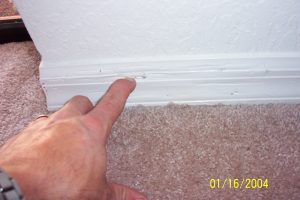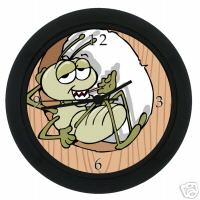 One of the most misunderstood aspects of pest control work is termite inspections. Even the best inspectors can only truly asses about 17% of the average home. Termite inspections account for well over half of all litigation in the pest industry and most of the gray hair on any termite inspectors head. Termites feed in the walls and sometimes the only evidence might be the size of a pinhead. Companies utilize dogs, thermal imaging, x-ray machines and listening devices to try and minimize the risk but nothing can truly be 100% . While customers demand a thorough inspection, some realtor’s frown on the use of any aids in detection seeing red flags as a commission killer. Whats more the pest industry does not do such a good job setting standards for such devices and most legal advice (at least all that I’ve heard in the countless meetings I’ve attended) actually say the inspector opens himself up to more ‘at fault risk’ if they employ such tools. Sadly then 9 out of 10 inspectors will revert to the ol tapping baseboards and a good flashlight. Most inspectors I know are very good at what they do but with the odds stacked against them it’s only a matter of time before they have to face an angry customer with termite woes neither of them saw coming.
One of the most misunderstood aspects of pest control work is termite inspections. Even the best inspectors can only truly asses about 17% of the average home. Termite inspections account for well over half of all litigation in the pest industry and most of the gray hair on any termite inspectors head. Termites feed in the walls and sometimes the only evidence might be the size of a pinhead. Companies utilize dogs, thermal imaging, x-ray machines and listening devices to try and minimize the risk but nothing can truly be 100% . While customers demand a thorough inspection, some realtor’s frown on the use of any aids in detection seeing red flags as a commission killer. Whats more the pest industry does not do such a good job setting standards for such devices and most legal advice (at least all that I’ve heard in the countless meetings I’ve attended) actually say the inspector opens himself up to more ‘at fault risk’ if they employ such tools. Sadly then 9 out of 10 inspectors will revert to the ol tapping baseboards and a good flashlight. Most inspectors I know are very good at what they do but with the odds stacked against them it’s only a matter of time before they have to face an angry customer with termite woes neither of them saw coming.
This article is mostly based on the rules of Florida, the state I work in and know best, however your state won’t be to far off from most of what is written. Check with your local inspectors but this should at least aid as a general guide.
A Wood Destroying Organism (WDO) Inspection Report is a written report of an inspection on a home for visible and accessible evidence of an infestation or damage by wood destroying organisms. Usually this means subterranean or dry wood termites, but will also cover wood destroying beetles and wood destroying fungi. In Florida,carpenter ants & carpenter bees do NOT have to be reported. Most northern states DO include these pests while excluding wood rot or wood decaying fungi.
A WDO report is also commonly called a ‘Termite Inspection’, ‘WDI’, ‘Clearance Letter’, or “Termite Letter”. A WDO inspection report is provided when a home or other structure is being sold and the mortgage lender or buyer requires the inspection as part of the transaction. If an inspection is done for these purposes, the inspection must be reported on a specific report form as required by Florida Law.(Chapter 482, Florida Statues). The form is sometimes called the “1145 report” because of the old form number.The new number is 13645. The WDO inspection can only be done by a wood destroying organisms identification card holder( or a certified operator within the wood-destroying organisms category) of a pest control company licensed by the state of Florida. These employees must receive special training to be qualified as WDO inspectors. A WDO report tells the buyer if the pest control inspector saw any of the following: * live termites or other wood destroying organisms. * evidence of infestation by termites or other wood destroying organisms(including wood decaying fungi). * damage by termites or other wood destroying organisms. *previous treatments for termites or other wood destroying organism. *The inspector must also report the common name of the wood destroying organism identified & the location of the evidence. If any areas are not accessible for the inspection these areas and the reason they are inaccessible must be reported.( For example-if an attic is not inspected,this must be noted and the phrasing “low crawl space” or other reasoning must be put on the form).
 A “ clear” report is a report that states that no evidence of wood destroying organisms infestation or damage was visible and accessible at the time of inspection. It does NOT mean, however, that the buyer can be absolutely assured that there are no wood destroying organisms infesting the structure or that there is no damage from termites or other wood destroying organisms. Such an infestation or damage may be hidden (therefore not visible and accessible), or may have been repaired by the seller and therefore not visible and accessible to the pest control inspector.
A “ clear” report is a report that states that no evidence of wood destroying organisms infestation or damage was visible and accessible at the time of inspection. It does NOT mean, however, that the buyer can be absolutely assured that there are no wood destroying organisms infesting the structure or that there is no damage from termites or other wood destroying organisms. Such an infestation or damage may be hidden (therefore not visible and accessible), or may have been repaired by the seller and therefore not visible and accessible to the pest control inspector.
Every year termites do more damage to homes in America then storms & fires combined, well until ‘Katrina’ hit, now they’re recalculating the figures but the damage is incredible. A simple termite inspection isn’t or shouldn’t be the only action you take while getting ready to invest in such a large purchase. In addition to the WDO inspection, home buyers should obtain written documentation of the following:
* termite treatments and termite protection contracts issued on the structure for at least the last 3 years (longer if available). ( Note: Florida law requires pest control companies to issue a written contract whenever termite or other WDO treatments are performed). * reports of annual inspections conducted as part of a termite protection contract. These reports will indicate if signs of infestation or damage were observed during the term of the protection contract. * any WDO inspections performed on the structure within the last year ( or longer if available).
Tips in choosing an inspection company “It’s your choice” Choosing an inspection company is not always easy but it is your choice. Some title companies and realtor’s have proven reliable inspectors they count on for these inspections. Sometimes it’s more of a matter of a cheaper price. Don’t let this be your guide. Ask for references or speak directly to your inspector to get a feel for his or her knowledge. Don’t use the same company that has done work on the home before. You’ll want a completely separate evaluation not one that may have protecting interests involved. Choose someone who’s not ‘lumped’ in with a host of other inspection services. This will keep his or her opinion separate and unswayed in the event repairs are necessary. Ask Questions. It will be to late when the inspection is done and you’ve purchased the home.





